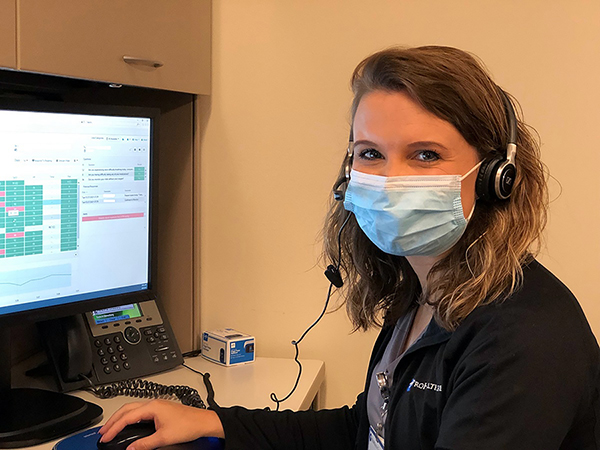 Cassandra Frank, ProHealth Care telemonitoring supervisor, and her team help provide care for COVID-19 patients recovering at home.
Cassandra Frank, ProHealth Care telemonitoring supervisor, and her team help provide care for COVID-19 patients recovering at home.Early in the COVID-19 pandemic, ProHealth Care clinical leaders and providers saw the need to monitor COVID-19 patients at home when they did not require inpatient care. Telemonitoring was launched to ensure the patients managed their own care successfully and to stay in touch with them in case they needed to see a provider in person.
Telemonitoring is considered for patients who have a respiratory-related diagnosis, suspected case of COVID-19, or are recovering from COVID-19. The process helps identify rapid decompensation that can occur with COVID-19 and ensure quick referrals. The service is complimentary for ProHealth patients who qualify for telemonitoring.
Physicians assess the severity of symptoms and health risk factors to determine whether a patient can safely recover at home and whether they need telemonitoring. Outpatients experiencing symptoms of COVID-19 first schedule virtual visits. The next step is a referral for testing. Inpatients and emergency department patients also may be considered for COVID-19 telemonitoring at discharge.
Upon referral to the program, patients receive a call from a trained telemonitoring nurse. An information sheet, pulse oximeter to measure heart rate and oxygen levels, and a log for recording oximeter readings, body temperature and symptoms are delivered to each patient at home.
Each patient also receives a daily call from a telemonitoring nurse to discuss their log entries, symptoms and health status. The nurse enters the information into the patient’s medical record and alerts the patient’s physician if there are immediate concerns. Patients can also call a dedicated phone number or their provider if they have questions or concerns.
When needed, the patient’s physician can provide care instructions or enter orders for additional testing or care. Most patients are monitored for 14 to 21 days.
Telemonitoring is also provided for eligible patients on supplemental oxygen after a complete evaluation. Once home oxygen is ordered by a physician, a respiratory therapist provides oxygen equipment and education to the patient before discharge.
They also receive instructions for oxygen use, a concentrator or oxygen tank and cart on loan, oxygen mask, tubing, and blood pressure cuff to take and log blood pressure readings. They are scheduled for regular virtual visits with a provider.
They also receive nursing assistance as they are weaned off of the oxygen.